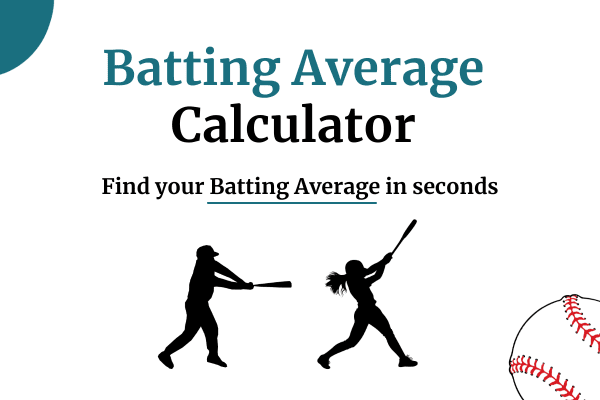Want to figure out your batting average? Use our Batting Average Calculator below to quickly discover the batting average of any hitter. Plus, there’s a guide about how to improve your batting average.
Batting Average Calculator ⚾
By the way, we also have other awesome baseball calculators and tools:
- ERA Calculator ⚾
- Slugging Percentage Calculator ⚾
- On Base Percentage Calculator (OBP) ⚾
- On Base Plus Slugging Calculator (OPS) ⚾
- Random MLB Team Generator ⚾
- WHIP Calculator ⚾
- FIP Calculator ⚾
Introducing the Batting Average Calculator
Whether you’re a baseball or softball player, coach, or even an avid fan—you’re certainly aware that the batting average is a key stat to evaluate a players’ performance.
And our Batting Average Calculator makes it easy to calculate batting average in just a click.
It works for baseball and softball.
To get your batting average with the Batting Average Calculator, do the following:
- Enter the number of hits.
- Enter the number of at-bats.
- Click “Calculate Batting Average” to get the result.

What is Batting Average?
Batting average is simple: it measures a hitter’s ability to get hits.
In other words, batting average tells us how often a hitter gets a hit when they step up to the plate.
A high batting average is a sign of a great hitter; in essence, means the batter is skilled at making contact and getting on base. A low batting average suggests that a hitter may be in a slump.
However, there are also other key indicators that are just as important, such as On Base Percentage (OBP), On Base Plus Slugging (OPS), and Slugging Percentage. (We have calculators for each of those too!)

What Formula is Used In the Batting Average Calculator?
Calculating batting average is simple with the right formula. Here it is:
Batting Average = Hits / At-Bats
Let’s break down each component:
- Hits: The total number of hits the hitter has.
- At-Bats: The total number of official at-bats the hitter has had.
The result is the hitter’s batting average, which tells us how many hits they’re likely to get in each at-bat.

What is the Difference Between Batting Average and On Base Percentage?
On Base Percentage (OBP) includes walks and hit by pitches, in addition to hits. This gives us a more complete picture of a hitter’s ability to get on base. This differs from batting average which is simply the number of hits divided by the number of at-bats.
Who Has the Best Batting Average in History?
A good batting average is generally above .300, while an average around .250 is considered average.
Of course, there have been legendary hitters over time that have achieved remarkable lifetime batting averages.
For instance, Hall of Famer Ty Cobb posted an astounding career batting average of .366.
Furthermore, in 1941, Ted Williams became the last player to hit over .400 in a season, finishing with a .406 average. Mindblowingly good!

How to Improve Your Batting Average: Tips for Hitting Success
Looking to raise your batting average? Here are some tips to help you excel at the plate:
- Focus on Pitch Recognition: Train your eye to recognize different pitch types and locations.
- Practice Hitting to All Fields: Work on hitting the ball to the opposite field, as well as pulling it.
- Develop a Consistent Swing: A smooth, repeatable swing is key to making solid contact.
- Stay Disciplined at the Plate: Avoid chasing bad pitches and wait for one you can drive.
- Learn from Each At-Bat: Analyze your at-bats and make adjustments as needed.
Remember, batting average is just one piece of the puzzle. A well-rounded hitter also excels in other areas, such as on-base percentage and power.
